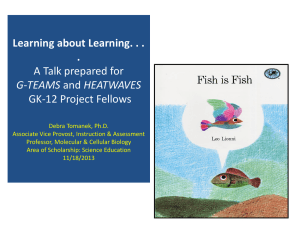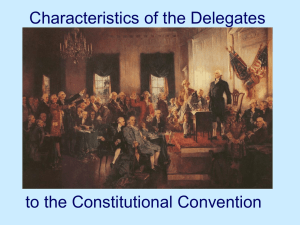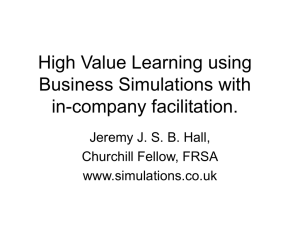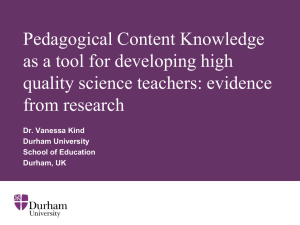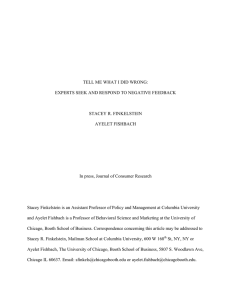Experts & Novices: Implications for Learning, Teaching and
advertisement
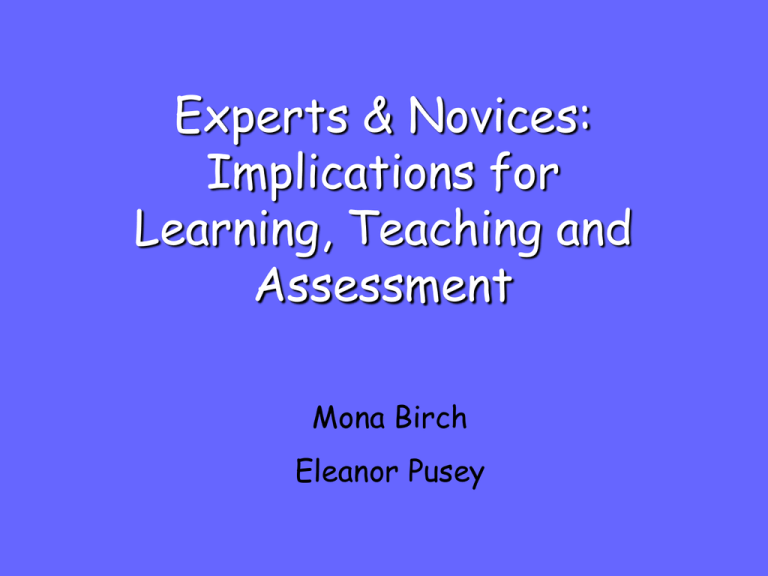
Experts & Novices: Implications for Learning, Teaching and Assessment Mona Birch Eleanor Pusey Expert or Novice? View the following clip and pay close attention to the mathematical reasoning used to show: 13 x 7 = 28 As your first test of “expert-ness”, be prepared to discuss the 3 methods used. http://www.youtube.com/watch?v=HLuhPBuy6-0&mode=related&search= Experts vs. Novices • Novices may just use information while experts make a deliberate effort to improve performance • Practice doesn’t make perfect; perfect practice makes perfect! Experts vs. Novices 3 important findings: 1. Experts have acquired mechanisms to change performances of novices 2. Novices use procedural knowledge without connection where an expert chooses the most appropriate and efficient strategy for the context 3. Experts help novices become independent learners by designing and monitoring their activities What is an Expert? “…experts excel mainly in their domain of expertise…perform their tasks (almost) error free, have superior short-term and long-term memory…” (Gog, Ericsson, Rikers, and Paas, 2005, p. 75) According to Schneider, it is “rich domainspecific knowledge” that defines an expert. K. Anders Ericsson Florida State University Conradi Eminent Scholar Cognitive Psychology Faculty Research Interests: • Thinking, reasoning and planning that mediate problem solving, learning and skilled performance. • The acquisition of expert performance through deliberate practice. • The structure and acquisition of LongTerm Working Memory. Wolfgang Schneider Wuerzburg, Germany Vice President of the Julius-Maximilians University Research topics include: • Memory development • Metacognition • Reading research Video interlude “Once you learn something it never leaves ya’…when you learn something, you learn it.” (Barnard P. Fife) http://www.youtube.com/watch?v=dns4ONyM_g&mode=related&search= Verbal Memory Do memory skills improve by factors indexed by age or because of experience? 1. A small percentage of people never acquire specific strategies indexed by an age 2. Memory development is advanced by learning experiences in school (Schneider, Knopf, and Stefanek, 2002) Children’s Memory Functioning • Students need a good background • Good background enables development of good strategies • The more “chunking” of material can prompt more general strategies (Schneider, Stefanek, & Knopf, 2002) “Chunking” (How People Learn, p. 52) Memory Task 4 7 1 0 2 3 0 4 3 6 2 1 1 4 8 8 7 4 2 9 1 5 2 7 9 Memory Task Memory Schemes ROWS SPIRAL Memory Schemes DIAGONAL COLUMNS Memory Task 4 7 1 0 2 3 0 4 3 6 2 1 1 4 8 8 7 4 2 9 1 5 2 7 9 Strategy Implications “Studies showed that children’s prior knowledge substantially affects their choice of memory strategies and significantly influences memory performance.” (Schneider, Korkel, and Weinert, 1989, p. 306) Understanding vs. Memorizing What does memorization have to do with understanding and vice versa? What holds these two ideas together? (How People Learn, p. 57) Key Principles - Experts 1. Meaningful Patterns 2. Conditionalized Knowledge 3. Big Ideas 4. Pedagogical Content Knowledge 5. Fluent Retrieval 6. Adaptive Expertise (Bransford, Brown, & Cocking, 2000) Principle #1: Patterns Experts notice features and meaningful patterns of information not noticed by novices • Chess example (Chase, Simon) • Data collected by Singley & Anderson about algebra courses • Providing “lecture readiness” (How People Learn, p. 59) Principle #1: Patterns What are some of the barriers in schools that might prevent students from learning this principle (i.e. noting meaningful patterns)? • Block scheduling • Mile wide/inch deep curriculum What solutions can address these barriers? Principle #1: Patterns As experts, you each have a set of heuristics that you draw on to solve particular types of problems. Categorize each type and identify specific strategies and procedures used to solve it. Example: Flying east between 2 cities, a plane’s speed is 380 miles per hour. On the return trip, it flies 420 miles per hour. Find the average speed for the round trip. Problem Types Jerry walks 1 block east along a vacant lot and then 2 blocks north to a friend’s house. Phil starts at the same point and walks diagonally through the vacant lot coming out at the same point as Jerry. If Jerry walked 217 feet east and 400 feet north, how far did Phil walk? A box containing 180 cubic inches is constructed by cutting each corner of a cardboard square a small square with side 5 inches, and then turning up the sides. Find the area of the original cardboard piece. (Problems from Hinsley, Hayes, & Simon, 1977) Problem Types Mr. Russo takes 3 minutes less than Mr. Lloyd to pack a case when each works alone. One day, after Mr. Russo spent 6 minutes in packing a case, the boss called him away and Mr. Lloyd finished packing in 4 more minutes. How many minutes would it take Mr. Russo alone to pack a case. Find the sum of the first 25 odd positive integers. If canned tomatoes come in 2 sizes, with radius of one 2/3 of the radius of the other, find the ratios of the capacities of the two cans. (Problems from Hinsley, Hayes, & Simon, 1977) Principle #2: Context/Access • Experts’ knowledge cannot be reduced to a set of isolated facts rather it reflects contexts of applicability Their knowledge is “conditionalized” on a set of circumstances Principle #2: Context/Access Example: When do you expose kids’ to word problems that require them to set up/solve a system of equations? • Gagne & Gibson’s strategy of “contrasting cases” (p. 60 HPL) Principle #3: Big Ideas • Experts have extensive content knowledge, organized in ways that reflect a deep understanding of their discipline Activity: Card Sort (Stein, M.K. et al, 1990) (Stein, M.K. et al, 1990) Expert teacher “In general, teachers with more explicit and better organized knowledge tend to provide instruction that features conceptual connections, appropriate and varied representations, and active and meaningful student discourse.” (Stein, M.K. et al, 1990, p. 641) Novice teacher “On the other hand, teachers with limited knowledge have been found to portray the subject as a collection of static facts; to provide impoverished or inappropriate examples, analogies, and/or representations; and to emphasize seatwork assignments and/or routinized student input as opposed to meaningful dialogue.” (Stein et al, 1990, p. 641) “Professional” 6 characteristics of professional teacher 1. Service to others (e.g. “calling”) 2. Scholarly understanding 3. Knowledge of skilled practice 4. Use of good judgment 5. Balance between theory and practice 6. Evaluation precipitates reflection (Shulman, 1998) Lee Shulman Stanford University 8th President of Carnegie Foundation Charles E. Ducommun Professor of Education & Psychology Emeritus AERA Distinguished Award-Contributions to Educational Research Research Interests: • Quality of Teaching & Teacher Education Principle #4: PCK (PCK - “pedagogical content knowledge”) • Experts have a strong grasp of their subject matter, but there is no guarantee that they possess the ability or expertise to teach others! Activity: PCK Items Principle #4: PCK Ms. Harris was working with her class on divisibility rules. She told her class that a number is divisible by 4 if and only if the last two digits of the number are divisible by 4. One of her students asked her why the rule for 4 worked. She asked the other students if they could come up with a reason, and several possible reasons were proposed. Which of the following statements comes closest to explaining the reason for the divisibility rule for 4? (Mark ONE answer.) a) Four is an even number, and odd numbers are not divisible by even numbers. b) The number 100 is divisible by 4 (and also 1000, 10,000, etc.). a) Every other even number is divisible by 4, for example, 24 and 28 but not 26. b) It only works when the sum of the last two digits is an even number. (SII/LMT Project, Deborah Ball) Principle #4: PCK Explain the concept of dilations. Provide a specific example that demonstrates how you would use geometric software to improve student understanding of the concept, and explain how your example would enhance student learning. (Retired prompt, Mathematics/Adolescence and Young Adulthood Certificate Area, National Board for Professional Teaching Standards) Principle #4: PCK Ms. Hernandez’s class was looking at the following table one day. She asked her students to think of a way that would help them find x for any given n, without having to continue the table. One student wrote, “The answer is x + 2.” Mrs. Hernandez was about to mark this student’s work as wrong when Mrs. Johnson, her student teacher, said she had a guess about what the student might have been thinking. In your opinion, what might this student have been thinking? (SII/LMT Project, Deborah Ball) n x 1 2 3 4 1 3 5 7 Principle #5: Fluent Retrieval • Experts are able to flexibly retrieve important aspects of their knowledge with little attentional effort • Knowledge retrieval may be automatic Principle #5: Fluent Retrieval Examples: A board was sawed in two pieces. One piece was 2/3 as long as the whole board and was exceeded in length by the second piece by four feet. How long was the board before it was cut? There are 26 sheep and 10 goats on a ship. How old is the captain? Principle #6: Adaptive Expertise • Experts have varying levels of flexibility in their approach to new situations • Experts use metacognition to monitor their memory status and regulate their strategies Principle #6: Adaptive Expertise “Metacognitively sophisticated children or adults are like busy executives, analyzing new problems, judging how far they are from the goal, allocating attention, selecting a strategy, attempting a solution, monitoring the success or failure of current performance, and deciding whether to change to a different strategy.” (Flavell, Miller, & Miller, 1993, p. 259) Can novices become experts? • Some novices have too many improvements to make • Some do not know how to make improvements • Some do not care enough to make improvements • Some are plagued by a mixture of the above (Ericsson, Krampe, & Tesch-Romer, 1993) Reflection on Key Principles Look back at the group tasks you completed in today’s lesson. Which key principle(s) of experts/novices was illustrated with the task? Memory Task Function Sort Problem Types PCK Items Disclaimers- Key Principles • All 6 of the key principles regarding experts are not discrete, but interconnected • Highly dependent on learner’s prior knowledge Implications for Instruction Instruction that enables students to see models of how experts organize and solve problems may be helpful. • Tasks should be authentic • Tasks should mirror learner’s needs and abilities • Learning should initiate self-assessment Implications for Assessment “Many designs for curriculum, instruction and assessment practices fail to emphasize the importance of conditionalized knowledge.” “Many assessments measure only propositional (factual) knowledge and never ask whether students know when, where, and why to use that knowledge.” (Bransford, Brown, & Cocking, 2000, p. 49) References Bransford, J.D., Brown, L. & Cocking, R.R. (Eds). (2000). How people learn: Brain, mind experience, and school. Washington, D.C.: National Academy Press. Ericsson, K., Krampe, R., & Tesch-Römer, C. (1993, July). The role of deliberate practice in the acquisition of expert performance. Psychological Review, 100(3), 363-406. Flavell, J.H., Miller, P.H., & Miller, S.A. (1993). Cognitive Development. Englewood Cliffs, NJ: Prentice Hall. van Gog, T., Ericsson, K., Rikers, R., & Paas, F. (2005). Instructional Design for Advanced Learners: Establishing Connections Between the Theoretical Frameworks of Cognitive Load and Deliberate Practice. Educational Technology Research & Development, 53(3), 73-81. References Hinsley, D. A., Hayes, J.R., & Simon, H.A. (1977). From words to equations: Meaning and representation in algebra word problems. In Cognitive Processes in Comprehension. Hillsdale, NJ: Lawrence Erlbaum Associates. Schneider, W., & Bjorklund, D. (1992, April). Expertise, aptitude, and strategic remembering. Child Development, 63(2), 461. Schneider, W., Körkel, J., & Weinert, F. (1989, September). Domain-specific knowledge and memory performance: A comparison of high- and low-aptitude children. Journal of Educational Psychology, 81(3), 306-312. References Schneider, W., Knopf, M., & Stefanek, J. (2002, December). The development of verbal memory in childhood and adolescence: Findings from the Munich Longitudinal Study. Journal of Educational Psychology, 94(4), 751-761. Shulman, L. (1998, May). Theory, practice, and the education of professionals. Elementary School Journal, 98(5), 513-523. Stein, M.K., Baxter J.A & Leinhardt, G. (1990, Winter) Subject matter knowledge and elementary instruction: A case from functions and graphing. American Educational Researcher 27(4): 639-663.
